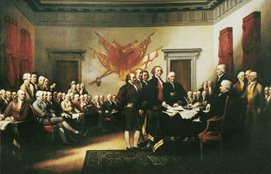
Just when I thought there was nothing left to write, after all 1776 had a wildly successful run but closed two weeks ago, I was watching the DVD preparing to narrate a "director's commentary" when I was struck by some dialogue that sent me back to the Internet for research. Consider these lines.
Dickinson: My dear Congress--you must not adopt this evil measure--it is the work of the devil. Leave it where it belongs--in New England!
Sherman: Brother Dickinson, New England has been fighting the devil for more than a hundred years.
Dickinson: As of now, "Brother" Sherman, the devil has been winning hands down!
My question was, "Why New England?" I'm sure you remember reading in high school, The Crucible, The Scarlett Letter, The Devil and Daniel Webster, The Devil and Tom Walker, the writings of Nathaniel Hawthorne and Cotton Mather; all about New England and the devil.
According to The Devil's Dominion: Magic and Religion in New England, "The New England colonists brought with them from England a variety of magical beliefs and practices. Most English men and women were aware of the folk practitioners who provided magical services. Many were skilled at healing and divining. Magic was very popular during this time and used often. Robert Burton a don at Christ Church Oxford (1599-1640) wrote that there were 'cunning men, wizards and white witches in every village which if sought into will help almost all infirmities of body and mind.'" Althought the good New Englanders were mostly Puritans, christianity and magical skills seemed to cooexist.
The reference might also have been to the Salem Witch trials a mere 84 years previous in 1692.



